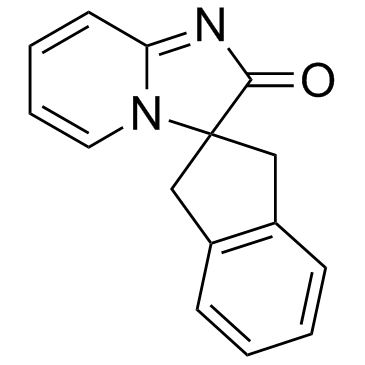ZSET1446 (ST-101) (Synonyms: ST-101) |
| رقم الكتالوجGC30807 |
ZSET1446 (ST-101) هو مُحسِّن معرفي جديد يعمل على تحسين عجز التعلم بشكل كبير في أنواع مختلفة من نماذج مرض الزهايمر (AD).
Products are for research use only. Not for human use. We do not sell to patients.

Cas No.: 887603-94-3
Sample solution is provided at 25 µL, 10mM.
ZSET1446 is a novel cognitive enhancer that significantly improves learning deficits in various types of Alzheimer disease (AD) models.
ZSET1446 (100 pM-10 nM) exerts limited effects on the basal neuronal excitability and synaptic transmission. ZSET1446 potentiates the facilitatory effect of nAChR stimulation on sPSC frequency. ZSET1446 potentiates the increase in sIPSC frequency by local application of nicotine (5 µM; 2 minutes) without affecting the basal sIPSC frequency at the range of 10 pM to 1 nM[1].
ZSET1446 enhances object recognition memory in mice and ameliorates cognitive impairment caused by scopolamine in rats. Concomitant administration of subeffective doses of ZSET1446 and memantine significantly ameliorates the cognitive performance in the novel object recognition task in both mice and rats. Moreover, oral administration of ZSET1446 or memantine increases the extracellular level of ACh in the hippocampus as compared with the control. Further, concomitant administration of subeffective doses of ZSET1446 and memantine significantly increases the extracellular level of ACh as compared with the group of ZSET1446 or memantine alone[2]. ZSET1446 (0.002, 0.01, and 0.1 mg/kg, p.o.) ameliorates cognitive deficits of SAMP8 after 4, 8, 12, and 16 weeks of treatment in a novel object recognition test. ZSET1446 also reduces grading scores of SAMP8 after 16 weeks of treatment. Further, 8-week treatment of ZSET1446 significantly reduces the total number of Aβ-positive granules in the hippocampus[3].
[1]. Takeda K, et al. Potentiation of Acetylcholine-Mediated Facilitation of Inhibitory Synaptic Transmission by an Azaindolizione Derivative, ZSET1446 (ST101), in the Rat Hippocampus. J Pharmacol Exp Ther. 2016 Feb;356(2):445-55. [2]. Yamaguchi Y, et al. Combination effects of ZSET1446/ST101 with memantine on cognitive function and extracellular acetylcholine in the hippocampus. J Pharmacol Sci. 2013;123(4):347-55. Epub 2013 Nov 29. [3]. Yamaguchi Y, et al. Effects of ZSET1446/ST101 on cognitive deficits and amyloid β deposition in the senescence accelerated prone mouse brain. J Pharmacol Sci. 2012;119(2):160-6.
Average Rating: 5 (Based on Reviews and 26 reference(s) in Google Scholar.)
GLPBIO products are for RESEARCH USE ONLY. Please make sure your review or question is research based.
Required fields are marked with *




















